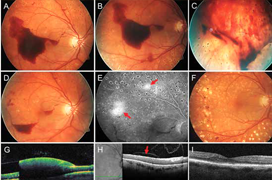Introduction: Premacular hemorrhage (PH) and sub-internal limiting membrane hemorrhage (sub-ILM-H) are among the causes of sudden deterioration of central visual acuity. Anatomical and functional outcomes of different therapeutic options were evaluated retrospectively.
Methods: The study included three eyes of three patients (2 females and 1 male). Location of the hemorrhage was determined by spectral domain optical coherence tomography. Subhyaloid premacular location of the hemorrhage was proven in one eye of each woman and sub-ILM location of the hemorrhage in one eye of the male. The baseline best corrected visual acuity (BCVA) was 0.63 in the eyes of the females and 0.16 in the eye of the male. Conservative treatment option was chosen in case of juxtafoveolar PH in the eye of the female patient on anticoagulant warfarin therapy. The female patient with PH secondary to proliferative diabetic retinopathy (PDR) underwent Nd: YAG laser hyaloidotomy. The male patient with unexplained cause of the sub-ILM-H underwent 25-Gauge vitrectomy with ILM peeling and subsequent ultrastructural morphometric and histopathological examination of the ILM.
Results: Both BCVA and retinal finding improvement were achieved in all patients. Final BCVA was 0.8 in the eye of the female patient with PDR and 1.0 in rest of the eyes of the other patients. No complications were recorded at follow-up visits. Histopathological and morphometric examination demonstrated variable ILM thickness (2.70 ±1.58 μm) and proved presence of fibroblasts and macrophages with hemosiderin deposits on the retinal side of ILM.
Conclusion: The choice of the treatment option of PH and sub-ILM-H depends on input parameters such as the initial BCVA, the extent and the location of the hemorrhage, as well as the overall health of the patient. Nd: YAG laser hyaloidotomy is an effective method for rapid recovery of visual functions. Surgical ILM peeling and aspiration of the underlying hemorrhage result in the removal of breakdown products of hemoglobin and minimization of the risk of secondary epiretinal membranes development.

